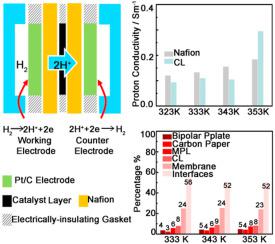当前位置:
X-MOL 学术
›
Prog. Nat. Sci. Mater. Int.
›
论文详情
Our official English website, www.x-mol.net, welcomes your feedback! (Note: you will need to create a separate account there.)
Experimental measurement of proton conductivity and electronic conductivity of membrane electrode assembly for proton exchange membrane fuel cells
Progress in Natural Science: Materials International ( IF 4.7 ) Pub Date : 2020-12-01 , DOI: 10.1016/j.pnsc.2020.10.016 Ruili Sun , Zhangxun Xia , Congrong Yang , Fenning Jing , Suli Wang , Gongquan Sun
Progress in Natural Science: Materials International ( IF 4.7 ) Pub Date : 2020-12-01 , DOI: 10.1016/j.pnsc.2020.10.016 Ruili Sun , Zhangxun Xia , Congrong Yang , Fenning Jing , Suli Wang , Gongquan Sun

|
Abstract Charge transport processes involving the proton migration and electron transfer for different parts of membrane electrode assemble (MEA) play an essential role for developing the novel electrode and enhancing the electrochemical performance towards proton exchange membrane fuel cells (PEMFCs). However, the coupled charge transport processes make it difficult for evaluating proton conductivity and electronic conductivity of different parts in MEAs under operation conditions of fuel cells. Here in this work, we propose an experiment approach for separating the electronic conductivity and proton conductivity of different components of MEA at the operating conditions of PEMFCs. This approach involves two different measuring devices, which both consist of electron or proton conducting layers, sealing layers and sample layer, followed by tailoring the thickness of sample layers and via electrochemical impedance spectroscopy (EIS) to quantity the electronic conductivity and proton conductivity of different layers. These experiment results show the great potential in the development of different components of MEA.
中文翻译:

质子交换膜燃料电池膜电极组件质子电导率和电子电导率的实验测量
摘要 涉及膜电极组件(MEA)不同部分的质子迁移和电子转移的电荷传输过程对于开发新型电极和提高质子交换膜燃料电池(PEMFC)的电化学性能起着至关重要的作用。然而,耦合的电荷传输过程使得在燃料电池的运行条件下评估 MEA 中不同部分的质子传导率和电子传导率变得困难。在这项工作中,我们提出了一种实验方法,用于在 PEMFC 的操作条件下分离 MEA 不同组分的电子电导率和质子电导率。这种方法涉及两种不同的测量设备,它们都由电子或质子传导层、密封层和样品层组成,然后调整样品层的厚度,并通过电化学阻抗谱 (EIS) 来量化不同层的电子电导率和质子电导率。这些实验结果显示了开发 MEA 不同组件的巨大潜力。
更新日期:2020-12-01
中文翻译:

质子交换膜燃料电池膜电极组件质子电导率和电子电导率的实验测量
摘要 涉及膜电极组件(MEA)不同部分的质子迁移和电子转移的电荷传输过程对于开发新型电极和提高质子交换膜燃料电池(PEMFC)的电化学性能起着至关重要的作用。然而,耦合的电荷传输过程使得在燃料电池的运行条件下评估 MEA 中不同部分的质子传导率和电子传导率变得困难。在这项工作中,我们提出了一种实验方法,用于在 PEMFC 的操作条件下分离 MEA 不同组分的电子电导率和质子电导率。这种方法涉及两种不同的测量设备,它们都由电子或质子传导层、密封层和样品层组成,然后调整样品层的厚度,并通过电化学阻抗谱 (EIS) 来量化不同层的电子电导率和质子电导率。这些实验结果显示了开发 MEA 不同组件的巨大潜力。



























 京公网安备 11010802027423号
京公网安备 11010802027423号